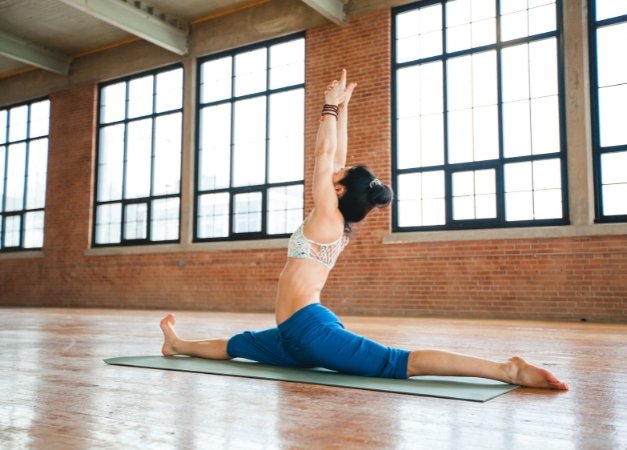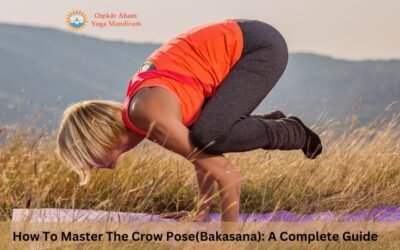As a yoga practitioner, you must have come across many challenging poses, but none is as iconic and beneficial as Hanumanasana, also known as the Monkey Pose. This pose requires immense flexibility, balance, and strength, but mastering it can help improve your posture, flexibility, and even your emotional state. In this article, we will discuss everything you need to know about Hanumanasana, including its benefits, how to do it, modifications, and tips to master it, with a focus on how 200-Hour Yoga Teacher Training In Rishikesh can help you achieve your goals.
What Is Hanumanasana?
Hanumanasana is an intermediate-level yoga pose that requires a deep lunge, splits, and a lot of flexibility in the hips, hamstrings, and quadriceps. This pose is named after Hanuman, a Hindu deity who was known for his courage, strength, and loyalty. In the pose, you have to mimic the famous leap of Hanuman, which requires you to stretch your legs wide apart, with one leg extended forward and the other leg extended backwards.
Benefits Of Hanumanasana
Hanumanasana

Hanumanasana
- Improves flexibility in the hips, hamstrings, and quadriceps
- Stretches the groin and inner thighs
- Stimulates the abdominal organs, improving digestion
- Helps in relieving stress and anxiety
- Enhances balance, focus, and concentration
- Increases blood circulation, providing a boost of energy
- Strengthens the legs, core, and back muscles
- Can help in alleviating menstrual discomfort
Preparing For Hanumanasana
Before attempting Hanumanasana, it’s essential to prepare your body with a few warm-up exercises and stretches. Here are some of them:
Warm-Up
- Start with some basic warm-up exercises, such as Tadasana, Mountain Pose, and Sun Salutations.
- Do some cardiovascular exercises, such as jogging, cycling, or jumping jacks to increase blood circulation.
Stretching Exercises
- Pigeon Pose (Eka Pada Rajakapotasana) – This pose stretches the hips and prepares them for Hanumanasana.
- Lizard Pose (Utthan Pristhasana) – This pose is similar to the Pigeon pose and can help open up your hips.
- Low Lunge (Anjaneyasana) – This pose stretches the quadriceps and hips and prepares them for the splits.

Hanumanasana Practice

Hanumanasana Practice
How To Do Hanumanasana
Now that you have warmed up and stretched your body, you can attempt Hanumanasana.
- Begin in a low lunge with your right foot forward and your left foot back.
- Slowly slide your left leg back as far as possible while keeping your hips squared.
- Keep your left knee and the top of your left foot on the ground.
- Slide your right foot forward until your right knee is directly above your ankle.
- Begin to straighten your right leg as much as possible while keeping both hips on the ground.
- Hold the pose for 5-10 deep breaths, then release and repeat.
Modifications Of Hanumanasana
Hanumanasana can be a challenging pose for many practitioners, and it’s important to modify the pose based on your flexibility level. Here are some modifications that you can try:
- Use props – Place a block or a bolster under your front thigh to support yourself and make the pose more accessible.
- Use a strap – If you can’t reach your front foot with your hands, use a strap to hold your foot and slowly move into the pose.
- Half Hanumanasana – Instead of going into a full split, you can try a half split by keeping your back leg bent and slowly straightening your front leg.
Tips To Master Hanumanasana
Hanumanasana requires patience, practice, and persistence. Here are some tips to help you master the pose:
- Practice consistently – Practice the pose regularly and incorporate it into your yoga routine.
- Focus on your breath – Deep breathing can help calm your mind and relax your muscles.
- Take it slow – Move slowly into the pose, listen to your body, and don’t force yourself into the pose.
- Engage your core – Engage your core muscles to stabilize your body and prevent any strain on your lower back.
- Practice variations – Try different variations of the pose, such as holding the pose for a longer time or incorporating it into a flow sequence.
How 200-Hour Yoga Teacher Training In Rishikesh Can Help You Achieve Your Hanumanasana Goals
Rishikesh, a city in Northern India, is known as the “Yoga Capital of the World.” It’s home to many renowned yoga schools and ashrams, including those that offer 200 Hour Yoga Teacher Training courses. These courses are designed to help you deepen your yoga practice and gain a deeper understanding of the philosophy and history of yoga.
By enrolling in a 200 Hour of Yoga Teacher Training in Rishikesh, you will learn the correct alignment, modifications, and adjustments of Hanumanasana and other challenging yoga poses. You will also learn different breathing techniques and meditation practices that can help you relax and focus during the pose.
Additionally, the course will provide you with a supportive community of fellow yogis and experienced teachers who can guide you through your practice and help you achieve your Hanumanasana goals.
Conclusion
Hanumanasana is a challenging but rewarding pose that can help improve your flexibility, balance, and strength. With consistent practice and patience, anyone can master the pose, regardless of their flexibility level. Enrolling in a 200 Hour Yoga Teacher Training in Rishikesh can provide you with the tools, knowledge, and support to deepen your yoga practice and achieve your Hanumanasana goals.
Join Our Omkar Aham Yoga Mandiram and experience our effective Yoga Teacher Training Rishikesh. For further details, contact us at:
Call/WhatsApp: +91-9997744876
Mail us at: info@yogateachertrainingschool.com




